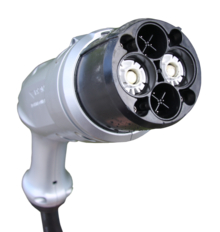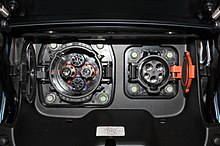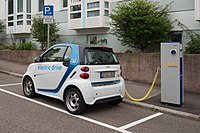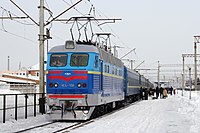CHAdeMO
 | |
 Charging station plug | |
| Formation | 2010 |
|---|---|
| Type | Nonprofit |
| Purpose | Development of electric vehicle charging technology |
| Website | chademo |
CHAdeMO is a fast-charging system for battery electric vehicles, developed in 2010 by the CHAdeMO Association, formed by the Tokyo Electric Power Company and five major Japanese automakers.[1] The name is an abbreviation of "CHArge de MOve" (which the organization translates as "charge for moving") and is derived from the Japanese phrase "o CHA deMO ikaga desuka" (お茶でもいかがですか), translating to English as "How about a cup of tea?", referring to the time it would take to charge a car.[1]
It competes with the Combined Charging System (CCS), which since 2014 has been required on public charging infrastructure installed in the European Union, Tesla's North American Charging Standard (NACS) used by its Supercharger network outside of Europe, and China's GB/T charging standard.
As of 2022[update], CHAdeMO remains popular in Japan, but is being equipped on very few new cars sold in North America or Europe.
First-generation CHAdeMO connectors deliver up to 62.5 kW by 500 V, 125 A direct current[2] through a proprietary electrical connector, adding about 120 kilometres (75 mi) of range in a half an hour. It has been included in several international vehicle charging standards.
The second-generation specification allows for up to 400 kW by 1 kV, 400 A direct current.[3][4] The CHAdeMO Association is currently co-developing with China Electricity Council (CEC) the third-generation standard with the working name of “ChaoJi” that aims to deliver 900 kW.[5]
History[edit]

CHAdeMO originated out of a charging system design from the Tokyo Electric Power Company (TEPCO). TEPCO had been participating on numerous EV infrastructure trial projects between 2006 and 2009 in collaboration with Nissan, Mitsubishi, Fuji Heavy Industries (now Subaru), and other manufacturers.[6] These trials resulted in TEPCO developing patented technology and a specification,[7] which would form the basis for the CHAdeMO.[8]
The first commercial CHAdeMO charging infrastructure was commissioned in 2009 alongside the launch of the Mitsubishi i-MiEV.[9]
In March 2010, TEPCO formed the CHAdeMO Association with Toyota, Nissan, Mitsubishi, and Subaru.[10] They were later joined by Hitachi, Honda and Panasonic.[11][12] CHAdeMO would be the first organization to propose a standardized DC fast charge system to be shared across diverse EVs, regardless of their brands and models.
CHAdeMO became a published international standard in 2014 when the International Electrotechnical Commission (IEC) adopted IEC 61851-23 for the charging system, IEC 61851-24 for communication, and IEC 62196-3 configuration AA for the connector. Later that year, the European Committee for Electrotechnical Standardization (EN) added CHAdeMO as a published standard along with CCS Combo 2, followed by the Institute of Electrical and Electronics Engineers (IEEE) in 2016.
A major blow to the international adoption of CHAdeMO came in 2013 when European Commission designated the Combined Charging System (CCS) Combo 2 as the mandated plug for DC high-power charging infrastructure in Europe.[13] While the European Parliament had contemplated transitioning out CHAdeMO infrastructure by January 2019, the final mandate only required that all publicly accessible chargers in the EU be equipped 'at least' with CCS Combo 2, allowing stations to offer multiple connector types.[14][15]
While CHAdeMO was the first fast-charging standard to see widespread deployment and remains widely equipped on vehicles sold in Japan, it has been losing market share in other countries. Honda was the first of the CHAdeMO Association members to stop equipping the connector on vehicles sold outside of Japan starting with the Clarity Electric in 2016. Nissan decided not to use CHAdeMO on its Ariya SUVs introduced in 2021 outside of Japan. Toyota and Subaru have also equipped their jointly developed bZ4X/Solterra with CCS connectors outside of Japan. As of June 2022[update], the Mitsubishi Outlander PHEV and Nissan Leaf are the only plug-in vehicles equipped with CHAdeMO for sale in North America.[16]
As demand increased for EV charging services for Tesla vehicles after 2019, and prior to opening of the competing North American Charging Standard (NACS) in late 2022, several electric vehicle charging network operators had added some Tesla charging connector adapters to CHAdeMO-standard charging stations. These included, ONroute rest stop network in Ontario, Canada—where a Tesla adaptor was permanently attached to a CHAdeMO connector on some 60 charge stations—[17] and REVEL opened a charging station in Brooklyn for a while after they were denied a license to operate a Tesla ride-hailing fleet in New York City.[18] Also, EVgo, added a few optional Tesla adaptors to CHAdeMO connectors as early as 2019.[19][20]
Connector design[edit]
 | |||
 CHAdeMO electric vehicle connector | |||
| Type | Automotive power connector | ||
|---|---|---|---|
| Production history | |||
| Produced | Since 2009 | ||
| General specifications | |||
| Diameter | 70 millimetres (2.8 in) | ||
| Pins | 10 (1 reserved) | ||
| Electrical | |||
| Signal | high-voltage DC | ||
| Pinout | |||
 | |||
| Pinouts for CHAdeMO, looking at end of vehicle connector | |||
| FG | Ground | reference for control lines | |
| SS1 / SS2 | Charge sequence signal | start/stop charging | |
| N/C | (not connected) | ||
| DCP | Charging enable | vehicle grants EVSE permission to connect power | |
| DC+ / DC- | DC power | supplied power | |
| PP | Connector proximity detection | charge interlock, disables drivetrain while connected | |
| C-H / C-L | CAN bus | communication with vehicle bus to establish operational parameters | |
DC fast charge[edit]
Most electric vehicles (EV) have an on-board charger that uses a full bridge rectifier to transform alternating current (AC) from the electrical grid to direct current (DC) suitable for recharging the EV's battery pack. Most EVs are designed with limited AC input power, typically based on the available power of consumer outlets: for example, 240 V, 30 A in the United States and Japan; 240 V, 40 A in Canada; and 230 V, 15 A or 3φ, 400 V, 32 A in Europe and Australia. AC chargers with higher limits have been specified, for example SAE J1772-2009 has an option for 240 V, 80 A and VDE-AR-E 2623-2-2 has a 3φ, 400 V, 63 A. But these charger types have been rarely deployed.
Cost and thermal issues limit how much power the rectifier can handle, so beyond approximately 240 V AC and 75 A it is better for an external charging station to deliver DC directly to the battery. For faster charging, dedicated DC chargers can be built in permanent locations and provided with high-current connections to the grid. Such high voltage and high-current charging is called a DC fast charge (DCFC) or DC quick charging (DCQC).[citation needed]
Connector protocols and history[edit]
While the notion of shared off-board DC charging infrastructure, together with the charging system design for CHAdeMO came out of TEPCOs trials starting in 2006, the connector itself had been designed in 1993, and was specified by the 1993 Japan Electric Vehicle Standard (JEVS) G105-1993 from the JARI.[21]
In addition to carrying power, the connector also makes a data connection using the CAN bus protocol.[22] This performs functions such as a safety interlock to avoid energizing the connector before it is safe (similar to SAE J1772), transmitting battery parameters to the charging station including when to stop charging (top battery percentage, usually 80%), target voltage, total battery capacity, and how the station should vary its output current while charging.[23]
The first protocol issued was CHAdeMO 0.9, which offered maximum charging power of 62.5 kW (125 A × 500 V DC). Version 1.0 followed in 2012, enhancing vehicle protection, compatibility, and reliability. Version 1.1 (2015) allowed the current to dynamically change during charging; Version 1.2 (2017) increased maximum power to 200 kW (400 A × 500 V DC).
CHAdeMO published its protocol for 400 kW (400 A × 1 kV) 'ultra-fast' charging in May 2018 as CHAdeMO 2.0.[24] CHAdeMO 2.0 allowed the standard to better compete with the CCS 'ultra-fast' stations being built around the world as part of new networks such as IONITY charging consortium.[25]
Vehicle-to-grid (V2G)[edit]
In 2014, CHAdeMO published its protocol for vehicle-to-grid (V2G) integration, which also includes applications for vehicle to load (V2L) or vehicle to home-off grid (V2H), collectively denoted V2X. The technology enables EV owners to use the car as an energy storage device, potentially lowering costs by optimising energy usage for the current time of use pricing and providing electricity to the grid.[26] Since 2012, multiple V2X demo projects using the CHAdeMO protocol have been demonstrated worldwide. Some of the recent projects include UCSD INVENT[27] in the United States, as well as Sciurus and e4Future[28] in the United Kingdom that are supported by Innovate UK.
CHAdeMO 3.0: ChaoJi[edit]
This section needs to be updated. The reason given is: CdM 3 was released in 2020; need update of tense and information. (September 2021) |

In August 2018, CHAdeMO Association announced they were co-developing the next-generation ultra-high-power protocol, named CHAdeMO 3.0, with China Electricity Council (CEC),[29] which would harmonise the CHAdeMO standard with the CEC GB/T charging standard 20234.3-2015. This project includes a new connector with the code name ChaoJi (Chinese: 超级; pinyin: Chāojí; lit. 'super'),[9] and plans to increase charging rate to 900 kW (600 A x 1.5 kV), all the while ensuring backward compatibility with the current CHAdeMO and GB/T 20234.3 (IEC 62916-3 configuration BB) DC chargers, according to the Association. It was revealed that ChaoJi can also be made backward compatible with CCS and such study is under consideration as of summer 2019.[30] The ChaoJi connector could also take the place of the DC connector of CCS Combo 2.[31]
By adopting liquid cooling within the cable and moving the locking mechanism from the connector to the vehicle, the ChaoJi connector is significantly lighter and more compact than the prior CHAdeMO design. IEC 68151-1 prohibits the use of adapters for high power charging; an amendment was submitted by the ChaoJi alliance to allow the use of adapters. A prototype adapter was built by Fujikura, but it was inflexible and heavy at nearly 3.5 kg (7.7 lb) because the cable did not use internal cooling.[9]
Deployment[edit]
Charging stations[edit]
CHAdeMO-type fast charging stations were initially installed in great numbers by TEPCO in Japan, which required the creation of an additional power distribution network to supply these stations.[32]
Since then, CHAdeMO charger installation has expanded its geographical reach and in May 2023, the CHAdeMO Association stated that there were 57,800 CHAdeMO chargers installed in 99 countries. These included 9,600 charging stations in Japan, 31,600 in Europe, 9,400 in North America, and 7,000 elsewhere.[33]
As of January 2022, a total of 260 certified CHAdeMO charger models have been produced by 50 companies.[34]
In vehicles[edit]

Models supporting CHAdeMO charging include:[citation needed][35]
- Bollinger B1
- BMW i3
- BYDJ6/K8
- Citroën C-ZERO
- Citroën Berlingo Electric/E-Berlingo Multispace (until 2020)
- ENERGICA MY2021[36]
- GLM Tommykaira ZZ EV
- Hino Dutro EV
- Honda Clarity PHEV
- Honda Fit EV
- Hyundai Ioniq Electric (2016)
- Hyundai Ioniq 5 (2023)
- Jaguar i-Pace
- Kia Soul EV (for American and European market until 2019)
- LEVC TX
- Lexus UX 300e (for Europe)
- Mazda Demio EV
- Mitsubishi Fuso eCanter
- Mitsubishi i MiEV
- Mitsubishi MiEV truck
- Mitsubishi Minicab MiEV
- Mitsubishi Outlander PHEV
- Mitsubishi Eclipse Cross PHEV
- Nissan LEAF
- Nissan e-NV200
- Peugeot e-2008
- Peugeot iOn
- Peugeot Partner EV
- Peugeot Partner Tepee
- Subaru Stella EV
- Tesla Model 3, S, X and Y (North American, Korean, and Japanese models via adapter,[37])
- Tesla Model S, and X (Models with European charge port via adapter, prior to models with integrated CCS 2 capability)
- Toyota eQ
- Toyota Prius PHV
- XPeng G3 (Europe 2020)
- Zero Motorcycles (via optional inlet)
- Vectrix VX-1 Maxi Scooter (via optional inlet)
Gallery[edit]
-
A TEPCO branded charger in Vacaville, California, U.S.
-
A charging site in Quebec, Canada with a 50 kW CHAdeMO / CCS "combo" DC fast charger and a Level 2 AC connector.
-
A "combo" fast charger station with Type 2, CHAdeMO, and CCS connectors
-
CHAdeMO plug
See also[edit]
- CCS Combo
- SAE J1772 (Type 1)
- ChaoJi
- GB/T charging standard
References[edit]
- ^ a b "General Outline of "CHAdeMO Association"" (PDF) (Press release). TEPCO. 15 March 2010. Retrieved 13 May 2010.
- ^ "What to Expect in New Connectors" (PDF). Fox Valley Electric Auto Association.
- ^ "CHAdeMO releases the latest version of the protocol enabling up to 400 kW". Archived from the original on 23 May 2020. Retrieved 14 September 2018.
- ^ "Protocol Development – Chademo Association". Retrieved 31 July 2019.
- ^ "CHAdeMO to jointly develop next-gen Ultra-Fast Charging Standard with China". Chademo Association. Archived from the original on 15 May 2019. Retrieved 31 July 2019.
- ^ Tillemann, Levi (2015). The Great Race: The Global Quest for the Car of the Future. New York: Simon & Schuster. pp. 131–133. ISBN 978-1-4767-7349-0.
- ^ "Tokyo Electric Power Licenses Aker Wade to Build Level III DC Fast Chargers". Green Car Congress. 15 January 2010. Retrieved 13 April 2010.
- ^ "Exclusive interview with the CEO of Aker Wade: "Standardisation is the key"". cars21.com. 29 April 2010. Archived from the original on 12 July 2018. Retrieved 13 May 2010.
- ^ a b c Blech, Tomoko (14–17 June 2020). Project ChaoJo: the background and challenges of harmonising DC charging standards. 33rd World Electric Vehicle Symposium & Exposition. Portland, Oregon. doi:10.5281/zenodo.4023281.
- ^ "Establishment of CHAdeMO Association" (Press release). TEPCO. 15 March 2010. Retrieved 13 May 2010.
- ^ Chuck Squatriglia (16 March 2010). "Let's Have Tea While Charging Our EV". Autopia. Wired.com. Retrieved 13 May 2010.
- ^ "History & Timeline – Chademo Association". Archived from the original on 16 April 2021. Retrieved 31 July 2019.
- ^ "EUR-Lex – 52013PC0018 – EN – EUR-Lex". eur-lex.europa.eu. Retrieved 22 June 2022.
- ^ Directive 2014/94/EU of the European Parliament and of the Council of 22 October 2014 on the deployment of alternative fuels infrastructure Text with EEA relevance, vol. OJ L, 28 October 2014, retrieved 22 June 2022
- ^ Eickelmann, Jens (2017). Driving Force Electromobility. Schieder, Germany: Phoenix Contact E-Mobility GmbH. p. 105. EMO03-17.000.L6.
- ^ Finkle, Joni (2 June 2022). "Can I Use Any Charger System with My EV?". Kelley Blue Book. Retrieved 22 June 2022.
- ^ Darryn John (11 February 2022). "Here's how Tesla owners will be able to use ONroute's new CHAdeMO EV chargers". Drive Tesla Canada.
- ^ Darryn John (29 June 2021). "Revel opens EV charging Superhub in Brooklyn after being blocked to operate in New York City". Drive Tesla Canada.
- ^ Andrew J. Hawkins (19 December 2019). "Tesla vehicles can soon be charged at EVgo charging stations in the US / The first connectors will be distributed at EVgo's charging stations in San Francisco". The Verge.
- ^ Herron, David (20 December 2019). "eVgo offers CHAdeMO fast charging to Tesla owners". The Long Tail Pipe. Long Tail Pipe. Retrieved 13 June 2023.
- ^ "Nissan Introduces Quick EV Charger" (Press release). Nissan. 21 May 2010. Archived from the original on 24 May 2010. Retrieved 21 May 2010.
- ^ "Technology Overview – Chademo Association". Archived from the original on 16 April 2021. Retrieved 3 June 2017.
- ^ Takafumi Anegawa (1 December 2010). "Safety Design of CHAdeMO Quick Charger and its impact on Power Grid" (PDF). TEPCO. Archived from the original (PDF) on 10 July 2011. Retrieved 25 January 2011.
- ^ "CHAdeMO releases the latest version of the protocol enabling up to 400 kW". Chademo Association. Archived from the original on 23 May 2020. Retrieved 21 August 2019.
- ^ "CHAdeMO is pushing for faster electric vehicle charging with new 400 kW protocol". 15 June 2018.
- ^ "V2X – Chademo Association". Retrieved 21 August 2019.
- ^ "UC SAN DIEGO EXPANDS TRITON RIDES PROGRAM WITH VEHICLE-TO-GRID SERVICE FROM NUVVE". NUVVE Corp. 30 October 2018. Archived from the original on 21 August 2019. Retrieved 21 August 2019.
- ^ "e4Future V2G – National Centre for Energy Systems Integration – Newcastle University". www.ncl.ac.uk. Retrieved 21 August 2019.
- ^ "CHAdeMO to jointly develop next-gen Ultra-Fast Charging Standard with China". Chademo Association. Archived from the original on 15 May 2019. Retrieved 21 August 2019.
- ^ "1st International ChaoJi Technical Workshop in Tokyo". Chademo Association. Archived from the original on 23 January 2021. Retrieved 21 August 2019.
- ^ Yoshida, Makoto Dave; Blech, Tomoko (13 April 2021). "Successful transition towards nation- and region-wide zero-emission transport systems" (PDF). CHAdeMO Association. Retrieved 9 August 2021.
- ^ André P. Slowak (27 June 2012). "Die Durchsetzung von Schnittstellen in der Standardsetzung: Fallbeispiel Ladesystem Elektromobilität" (PDF). Fzid Discussion Papers (in German). Universität Hohenheim, Forschungszentrum Innovation und Dienstleistung: 29. ISSN 1868-0720. Archived from the original (PDF) on 23 October 2015. Retrieved 19 July 2012.
Die deutsche Industrie greift auf das herkömmliche Stromverteilernetz zurück. Tepco hingegen hat für CHAdeMO ein eigenes Verteilernetz aufgebaut.
- ^ "Chademo Association – EV Fast Charging Organisation". Archived from the original on 7 March 2010. Retrieved 15 November 2023.
- ^ "CHAdeMO-certified charger list" (PDF). Archived (PDF) from the original on 17 May 2017. Retrieved 14 January 2022.
- ^ "CHAdeMO Association". CHAdeMO Association. 28 February 2024. Retrieved 28 February 2024.
- ^ "Energica MY2021 Motorcycles now equipped with the CHAdeMO charging system". Energica. 28 January 2021. Retrieved 29 December 2021.
- ^ "CHAdeMO Adapter". Archived from the original on 13 August 2019. Retrieved 13 June 2019.






